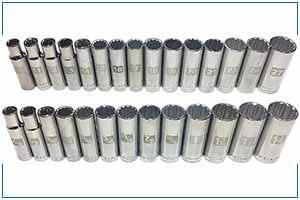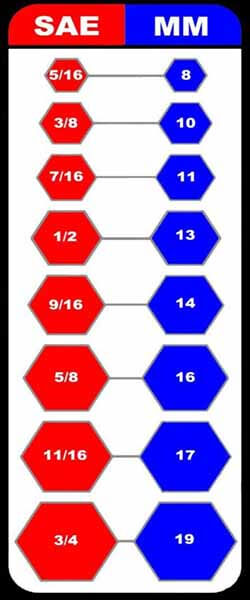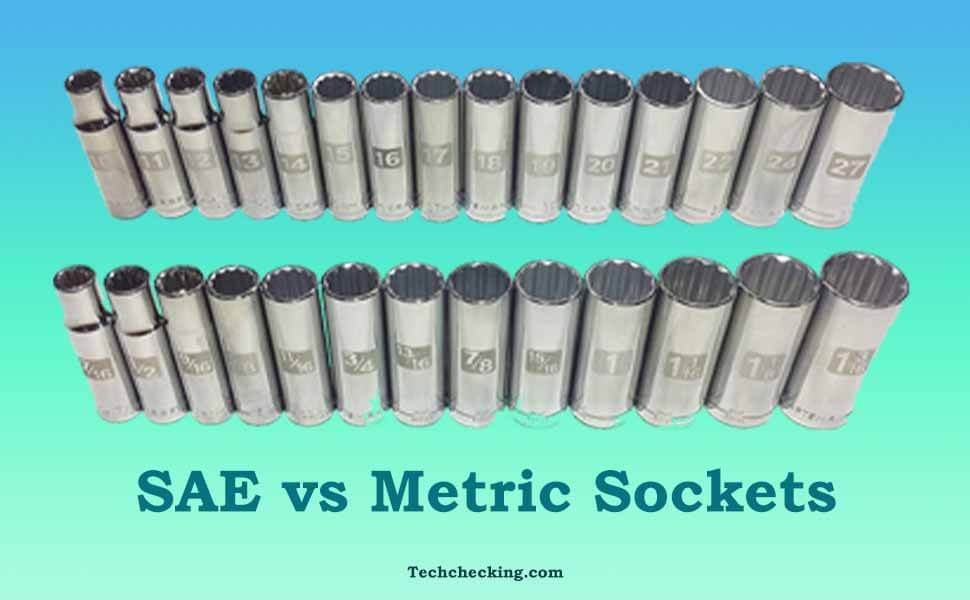Last Updated on January 11, 2023 by TechChecking
Wrenches and sockets are essential tools for fastening or unfastening nuts or bolts from any vehicle or different types of projects. “SAE” and “Metric” both of them are the measurement systems of sockets and wrenches tools. We know the vast use of these kinds of tools. As SAE and metric sockets are different in measurement, they are important to know. Which countries use which system is also necessary to know. In this article, SAE vs Metric sockets would be a great comparison. Besides, socket sizes in order in both SAE and metric systems are important too. If you are willing to know the various information about sae vs metric sockets, you should read the whole article.
Contents
- What is SAE?
- What is Metric?
- Common SAE Socket Sizes
- Common Metric Socket Sizes
- Common Axle/Spindle Nut Sizes
- Can I use Metric sockets on SAE fasteners or Vice-Versa?
- SAE vs Metric: Which One Is the Best to Buy?
- How to Identify Different Bolts and Nuts?
- Why are There No Metric Drive Sizes?
- SAE Socket Sizes in Order
- Metric Socket Sizes in Order
- SAE to Metric Conversion Chart
- Socket Sizes in Order from Smallest to Largest
- Final Words
What is SAE?
SAE stands for Society of Automotive Engineers. It is one kind of measurement system that is originated from imperial English. So the origin of the SAE standard comes from the English or the Imperial system. The SAE measurement system uses inches and fractions to designate the different socket and wrench sizes. For example, the sizes could be 1/2”, 3/8”, 13/16”, etc. In the 1970s, this sae system was used to apply the US-made trucks and cars.
What is Metric?
Like SAE, the metric is one kind of measurement system that is based on millimeters. While the sae system is very common in the US, the metric measurement system is found all over the world. However, this system is most common in Europe. The metric socket sizes, for example, are 8mm, 10mm, 12mm, and, so on. Truth be told, the metric system allows you to measure sockets very accurately with the very smallest increments. As we all know one millimeter is equivalent to 3/64 of an inch and thus you can get the exact measurement.
Common SAE Socket Sizes

We know, SAE sockets are also known as imperial or standard sockets. They come in different sizes. The most commonly used SAE wrench and socket sizes are 5/16″ ,3/8″, 7/16″ ,1/2″ ,9/16″ ,5/8″ ,11/16″ ,3/4″ ,13/16″ ,7/8″ ,1″ ,1-1/4″ ,1-7/16″ ,1-1/2″. Besides, any larger than around 7/8″ is usually on an as-needed basis. The largest one is 1”. Honestly, unless you intend to work on heavy-duty trucks or cars, you must not need the 1-1/4″ or larger. You should also know how to measure socket drive sizes.
Common Metric Socket Sizes

The question may be what are the most common sizes for metric sockets? Well, metric socket sizes also come in different sizes. The most common metric sizes for sockets are between 8mm and 19mm. however, in terms of car repair, the most common size is the 10mm socket. Besides the 10mm socket, 12mm, 14mm, 17mm, and 19mm are all fairly common as well.
Common Axle/Spindle Nut Sizes
We will now see some mostly used axle and spindle nut sizes using a table so that we can easily understand. Different types of socket wrenches are seen all over the globe. Let’s see those.
| Vehicle’s Name | Name of the Nut | Size of the Nut |
|---|---|---|
| Honda | Axle/spindle nut | 32mm |
| Chevys and Toyotas | Axle/spindle nut | 30 mm |
| Mitsubishi | Axle/spindle nut | 32 mm |
| Volkswagens | Axle/spindle nut | 30 mm 12-point nuts |
| C5 and C6 Corvettes | Spindle nut | 34 mm |
| Mid 90’s BMW | Hub nut | 46mm |
| Honda JDM | Axle and/or spindle nut | 36mm |
| Nissan (different models) | Axle and/or spindle nut | 30mm/ 32mm/ or 36mm |
| General Motors (GM) | Axle nut | 34mm or 36mm |
| Kia | Spindle Nut | 35mm/ 36mm |
| Mazda | Axle nut | 30mm, 32mm, 35mm |
| Toyota Tundra | Axle nut | 39mm |
| Landcruiser | Axle nut | 39mm |
| Highlander | Axle nut | 39mm |
| Astro Vans | Axle nut | 27mm |
Can I use Metric sockets on SAE fasteners or Vice-Versa?
Are SAE & Metric interchangeable? The answer is yes, you can in some cases. There are some sockets on both metric and SAE sizes that are pretty matched. But, you must have to be cautious about them because if they are not exactly the same, there is a higher possibility to strip the bolt you are working on. You should know different types of socket wrenches and their uses. How to use socket wrenches with different types of socket wrenches is important to know too.

We have tried to show you a chart to make you understand. It shows the crossover between metric sockets and standard sockets. Choosing the right tool is important. So, be careful when buying a tool.
Here is a general rule of thumb for metric / SAE sockets that are the same (or close enough):
| SAE System Measurement | Metric System Measurement |
|---|---|
| 5/16″ | 8mm |
| 7/16″ | 11mm |
| 1/2″ | 13mm |
| 9/16″ | 14mm |
| 5/8″ | 16mm |
| 11/16″ | 17mm |
| 3/4″ | 19mm |
| 7/8″ | 22mm |
| 15/16″ | 24mm |
| 1-1/16″ | 27mm |
| 1.5″ | 38mm |
Again, those guidelines are very important to remember. However, if you find the socket or wrench that does not fit your bolt, well then, go buy the SAE or metric-sized socket you need before you strip anything important.
SAE vs Metric: Which One Is the Best to Buy?
SAE or metric – the one you should buy depends on what car you are using and intending to repair. If you need to work on imported cars like Honda, Toyota, Kia, Hyundai, Subaru, Mitsubishi, Nissan, etc. you will certainly need metric sockets. Roughly 9/10 of imported cars require metric sockets to fasten or unfasten their nuts or bolts while you might not ever need to use SAE tools for these imported cars.
However, if you are working on only domestic cars, you may likely need both the SAE and metric sockets. In addition, all Japanese, Korean and German brands are metric. In some cases, some US brands are all SAE or are all metric, or sometimes even worse. You would be surprised to know that some US brands used half metric and half SAE during certain years.
It would be great if all the manufacturers used to manufacture a universal size that would make no comparisons between different measurement systems. Yes, you can convert the sizes from SAE to metric but the size sometimes may not match the exact same.
Well, if you want to hear my point of view, I would then highly recommend filling out socket sets with metrics first, and then you can buy or find any size of SAE sockets. Most importantly, this all depends on what kind and model of car you use. It is true that metric systems are definitely more demandable.
How to Identify Different Bolts and Nuts?
What kind of job you are doing or especially depending on what kind of vehicles or DIY project you are working on, the sizes of nuts and bolts differ. As mentioned earlier showing a table different cars use different sizes of sockets and wrenches. So, the question again is how can I identify different bolts and nuts? Well, the manufacturers usually identify different bolts and nuts by testing different parts such as screws, nuts, and bolts by things like major diameter, length, type, pitch, class, and so on. know more from here.
Each of these variables is important and all the nuts and bolts should have the information stamped on the face.
Tensile Strength
This factor of the bolt is not an indicator on the head. A soft bolt is which has a tensile strength of less than 64,000 PSI.
Grade five bolts – a bolt head that has 3 raised slots stamped on it indicates medium carbon steel. You should know this is a minimum commercial quality that comes with a tensile strength of at least 105,000 psi.
Grade six bolts – tensile strength of at least a 133,000-psi capacity is tempered. It indicates a medium commercial quality too.
Grade eight bolts – these are medium carbon alloy bolts that are tempered and quenched and rated for 150,000 psi. However, these bolts are considered the best commercial quality.
Grade 12 bolts – some bolts are used for critical and competition purposes. These grade 12 bolts have special alloy steel and are tempered and quenched as well. If you are wondering what category will these grade 12 bolts fall? Well, these are the top-of-the-line bolts in terms of tensile strength.
Why are There No Metric Drive Sizes?
You may know can generally find both SAE and metric sockets in three different drive sizes. They are 1/4”, 3/8”, and 1/2”. Though the original ratchet was an American invention, the metric sockets are very available now. You can get it all over the world.
However, the dimensions of the drivers always follow the US sizes such as 1/4”, 3/8”, 3/4, and 1/2”. Believe it or not, this is a good thing that metric sockets don’t have any ratchet to match it. It means you don’t have to buy another set for your metric sizes. Truth be told, it would be a great pain if metric sockets would have their own special ratchets with metrically sized drivers.
SAE Socket Sizes in Order
SAE Socket Sizes in Order is important to know. Since there are different sizes of sockets out there, knowing SAE Socket Sizes in Order is really essential. In this sae vs metric sockets, we will first learn about the SAE socket sizes in order and then metric socket sizes. Let’s see the sae socket sizes in order now.
| 1/4” Drive | 3/8” Drive | 1/2” Drive | 3/4” Drives | 1” Drives |
| 5/32″ | 1/4″ | 3/8″ | 7/8″ | 1-5/8″ |
| 3/16″ | 5/16″ | 7/16″ | 15/16″ | 1-11/16″ |
| 7/32″ | 3/8″ | 1/2″ | 1″ | 1-3/4″ |
| 1/4″ | 7/16″ | 9/16″ | 1-1/16″ | 1-13/16″ |
| 9/32″ | 1/2″ | 19/32″ | 1-1/8″ | 1-7/8″ |
| 5/16″ | 9/16″ | 5/8″ | 1-3/16″ | 2″ |
| 11/32″ | 5/8″ | 21/32″ | 21/32″ | 2-1/8″ |
| 3/8″ | 11/16″ | 11/16″ | 1-5/16″ | 2-3/16″ |
| 7/16″ | 3/4″ | 3/4″ | 1-3/8″ | 2-1/4″ |
| 1/2″ | 13/16″ | 25/32″ | 1-7/16″ | 2-3/8″ |
| 9/16″ | 7/8″ | 13/16″ | 1-1/2″ | 2-1/2″ |
| 15/16″ | 7/8″ | 1-5/8″ | 2-5/8″ | |
| 1″ | 15/16″ | 1-11/16″ | 2-3/4″ | |
| 1″ | 1-3/4″ | 2-15/16″ | ||
| 1-1/16″ | 1-13/16″ | 3″ | ||
| 1-1/8” | 1-7/8” | 3-1/8” | ||
| 1-3/16″ | 2″ | |||
| 1-1/4” | 2-1/8” | |||
| 1-1/2″ | 2-3/16″ | |||
| 2-1/4” |
Metric Socket Sizes in Order
We, especially professionals who work these related jobs, should know about the socket sizes in order. As this is a topic of sae vs metric sockets, we will now learn the metric socket sizes in order.
| 1/4” Drive | 3/8” Drive | 1/2” Drive | 3/4” Drive | 1” Drive |
| 4mm | 5.5mm | 8mm | 19mm | 36mm |
| 4.5mm | 6mm | 9mm | 20mm | 38mm |
| 5mm | 7mm | 10mm | 21mm | 41mm |
| 5.5mm | 8mm | 11mm | 22mm | 46mm |
| 6mm | 9mm | 12mm | 23mm | 50mm |
| 7mm | 10mm | 13mm | 24mm | 54mm |
| 8mm | 11mm | 14mm | 25mm | 55mm |
| 9mm | 12mm | 15mm | 26mm | 58mm |
| 10mm | 13mm | 16mm | 27mm | 60mm |
| 11mm | 14mm | 17mm | 28mm | 63mm |
| 12mm | 15mm | 18mm | 29mm | 65mm |
| 13mm | 16mm | 19mm | 30mm | 67mm |
| 14mm | 17mm | 20mm | 31mm | 70mm |
| 15mm | 18mm | 21mm | 32mm | 71mm |
| 19mm | 22mm | 33mm | 75mm | |
| 20mm | 23mm | 34mm | 77mm | |
| 21mm | 24mm | 35mm | 80mm | |
| 22mm | 25mm | 36mm | ||
| 26mm | 38mm | |||
| 27mm | 40mm | |||
| 28mm | 41mm | |||
| 30mm | 42mm | |||
| 32mm | 45mm | |||
| 46mm | ||||
| 48mm | ||||
| 50mm |
SAE to Metric Conversion Chart
Sometimes we don’t know which size is an exact match to another. The topic sae vs metric sockets demand the SAE to Metric Conversion Chart so that users can easily get the information and convert SAE to metric without any problems and vice-versa. This is why, sae to metric conversion chart is so necessary. Let’s check it out.
| SAE Size | Metric Size | Inches Decimal | Additional Information |
| 5/32″ | 0.156 | 5/32″ and 4mm are close enough | |
| 4mm | 0.157 | ||
| 4.5mm | 0.177 | ||
| 3/16″ | 0.188 | ||
| 5mm | 0.197 | ||
| 5.5mm | 0.216 | ||
| 7/32″ | 0.219 | ||
| 6mm | 0.236 | ||
| 1/4″ | 0.250 | ||
| 6.5mm | 0.256 | ||
| 7mm | 0.276 | ||
| 9/32″ | 0.281 | ||
| 5/16″ | 0.313 | 5/16″ and 8mm are close enough | |
| 8mm | 0.315 | ||
| 11/32″ | 0.344 | ||
| 9mm | 0.354 | ||
| 3/8″ | 0.375 | ||
| 10mm | 0.394 | ||
| 13/32″ | 0.406 | ||
| 11mm | 0.433 | ||
| 7/16″ | 0.438 | 7/16″ and 11mm are close enough | |
| 15/32″ | 0.469 | 15/32″ and 12mm are close enough | |
| 12mm | 0.472 | ||
| 1/2″ | 0.500 | ||
| 13mm | 0.512 | ||
| 17/32″ | 0.531 | ||
| 14mm | 0.551 | ||
| 9/16″ | 0.563 | ||
| 15mm | 0.591 | ||
| 19/32″ | 0.594 | 19/32″ and 15mm are close enough | |
| 5/8″ | 0.625 | 5/8″ and 16mm are close enough | |
| 16mm | 0.630 | ||
| 21/32″ | 0.656 | ||
| 17mm | 0.669 | ||
| 11/16″ | 0.688 | ||
| 18mm | 0.709 | ||
| 23/32″ | 0.719 | ||
| 19mm | 0.748 | ||
| 3/4″ | 0.750 | 3/4″ and 19mm are close enough | |
| 25/32″ | 0.781 | ||
| 20mm | 0.787 | ||
| 13/16″ | 0.813 | ||
| 21mm | 0.827 | ||
| 27/32″ | 0.844 | ||
| 22mm | 0.866 | ||
| 7/8″ | 0.875 | ||
| 23mm | 0.906 | ||
| 29/32″ | 0.906 | 29/32″ and 23mm are close enough | |
| 15/16″ | 0.938 | ||
| 24mm | 0.945 | ||
| 25mm | 0.984 | ||
| 1″ | 1.000 | ||
| 26mm | 1.024 | ||
| 1-1/16″ | 1.063 | 1-1/16″ and 27mm are close enough | |
| 27mm | 1.063 | ||
| 28mm | 1.102 | ||
| 1-1/8″ | 1.125 | ||
| 29mm | 1.142 | ||
| 30mm | 1.181 | ||
| 1-3/16″ | 1.188 | ||
| 31mm | 1.220 | ||
| 1-1/4″ | 1.250 | ||
| 32mm | 1.260 | ||
| 33mm | 1.299 | ||
| 1-5/16″ | 1.313 | ||
| 34mm | 1.339 | ||
| 1-3/8″ | 1.375 | 1-3/8″ and 35mm are close enough | |
| 35mm | 1.378 | ||
| 36mm | 1.417 | ||
| 1-7/16″ | 1.438 | ||
| 37mm | 1.457 | ||
| 38mm | 1.496 | ||
| 1-1/2″ | 1.500 | 1-1/2″ and 38mm are close enough |
Socket Sizes in Order from Smallest to Largest
| Drive Socket Size | Metric Socket Head Sizes Available | Imperial Socket Head Sizes Available |
| 1/4″ | 3, 3.2, 3.5, 4, 4.5, 5, 5.5, 6, 7, 8, 9, 10, 11, 12, 13, 14mm | 5/32, 3/16, 7/32, 1/4, 9/32, 5/16, 11/32, 3/8, 7/16, 1/2″ |
| 3/8″ | 5.5, 6, 7, 8, 9, 10, 11, 12, 13, 14, 15, 16, 17, 18, 19, 20, 21, 22mm | 1/4, 5/16, 11/32, 3/8, 7/16, 1/2, 9/16, 5/8, 11/16, 3/4, 13/16, 7/8″ |
| 1/2″ | 8, 9, 10, 11, 12, 13, 14, 15, 16, 17, 18, 19, 20, 21, 22, 23, 24, 25, 26, 27, 28, 30, 32mm | 3/8, 7/16, 1/2, 9/16, 5/8, 11/16, 3/4, 13/16, 7/8, 15/16, 1, 1-1/16, 1-1/8, 1-3/16, 1-1/4″ 3/4″ |
| 3/4″ | 19, 22, 24, 26, 27, 28, 30, 32, 34, 36, 38, 41, 42, 45, 46, 48, 50mm | 5/16, 1-1/8, 1-3⁄16, 1-1/4, 1-5/16, 1-3/8, 1-7/16, 1-1/2, 1-5/8, 1-3/4” |
| 1″ | 36, 38, 41, 46, 50, 54, 55, 58, 60, 63, 65, 67. 70, 71, 75, 77, 80mm | 15/16, 1, 1-1/16, 1-1/8, 1-1/4, 1-5/16, 1-1/2″ |
Final Words
In this SAE vs Metric sockets article, we have tried to cover everything you know immaculately. We hope you will find this article helpful. If you want to know more about sae vs metric sockets, you know how to reach out to us.
Articles You May Like –
- Best Adjustable Wrenches
- 3/8 Vs 1/2 Impact Wrench
- Wrench Sizes In Order
- How To Use A Socket Wrench To Loosen A Bolt
- Monkey Wrench Vs Pipe Wrench

